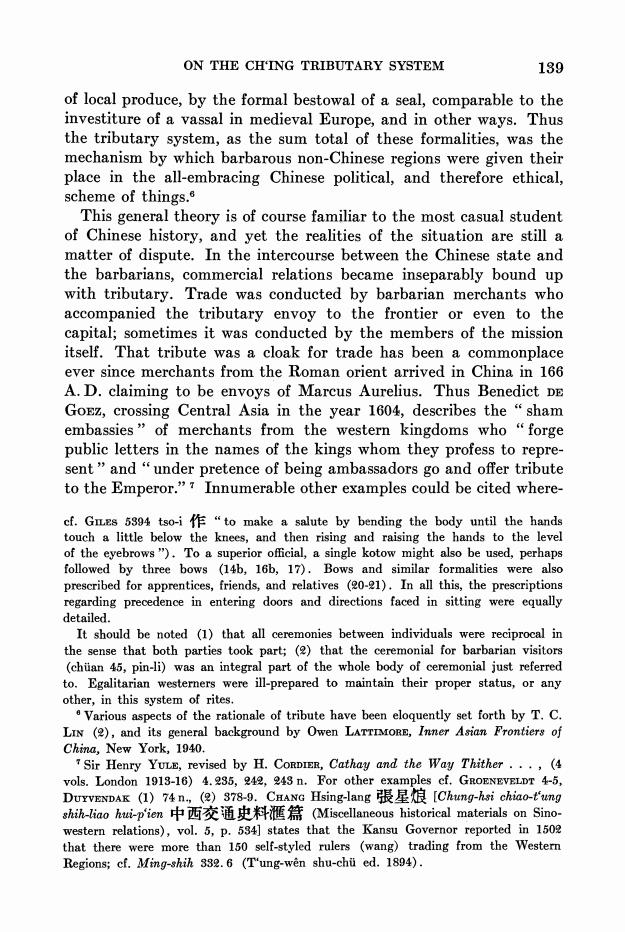正在加载图片...

ON THE CH'ING TRIBUTARY SYSTEM 189 of local produce,by the formal bestowal of a seal,comparable to the investiture of a vassal in medieval Europe,and in other ways.Thus the tributary system,as the sum total of these formalities,was the mechanism by which barbarous non-Chinese regions were given their place in the all-embracing Chinese political,and therefore ethical, scheme of things.3 This general theory is of course familiar to the most casual student of Chinese history,and yet the realities of the situation are still a matter of dispute.In the intercourse between the Chinese state and the barbarians,commercial relations became inseparably bound up with tributary.Trade was conducted by barbarian merchants who accompanied the tributary envoy to the frontier or even to the capital;sometimes it was conducted by the members of the mission itself.That tribute was a cloak for trade has been a commonplace ever since merchants from the Roman orient arrived in China in 166 A.D.claiming to be envoys of Marcus Aurelius.Thus Benedict DE GoEz,crossing Central Asia in the year 1604,describes the "sham embassies"of merchants from the western kingdoms who "forge public letters in the names of the kings whom they profess to repre- sent"and"under pretence of being ambassadors go and offer tribute to the Emperor."7 Innumerable other examples could be cited where- cf.GIes 5394 tso-i "to make a salute by bending the body until the hands touch a little below the knees,and then rising and raising the hands to the level of the eyebrows").To a superior official,a single kotow might also be used,perhaps followed by three bows (14b,16b,17).Bows and similar formalities were also prescribed for apprentices,friends,and relatives (20-21).In all this,the prescriptions regarding precedence in entering doors and directions faced in sitting were equally detailed. It should be noted (1)that all ceremonies between individuals were reciprocal in the sense that both parties took part;(2)that the ceremonial for barbarian visitors (chiian 45,pin-li)was an integral part of the whole body of ceremonial just referred to.Egalitarian westerners were ill-prepared to maintain their proper status,or any other,in this system of rites. Various aspects of the rationale of tribute have been eloquently set forth by T.C. LIN (2),and its general background by Owen LATTIMORE,Inner Asian Frontiers of China,New York,1940. 1Sir Henry YuLe,revised by H.CoRDIEB,Cathay and the Way Thither...,(4 vols.London 1913-16)4.235,242,243 n.For other examples ef.GROENEVELDT 4-5, DUYVENDAK (1)74 n.,(378-9.CHANG Hsing-lang [Chung-hsi chiao-t'ung shih-liao hui-p'ien中西交通史料滙篇(Miscellaneous historical materials on Sino- western relations),vol.5,p.534]states that the Kansu Governor reported in 1502 that there were more than 150 self-styled rulers (wang)trading from the Western Regions;cf.Ming-shih 332.6 (T'ung-wen shu-chu ed.1894).ON THE CH'ING TRIBUTARY SYSTEM 139 of local produce, by the formal bestowal of a seal, comparable to the investiture of a vassal in medieval Europe, and in other ways. Thus the tributary system, as the sum total of these formalities, was the mechanism by which barbarous non-Chinese regions were given their place in the all-embracing Chinese political, and therefore ethical, scheme of things.6 This general theory is of course familiar to the most casual student of Chinese history, and yet the realities of the situation are still a matter of dispute. In the intercourse between the Chinese state and the barbarians, commercial relations became inseparably bound up with tributary. Trade was conducted by barbarian merchants who accompanied the tributary envoy to the frontier or even to the capital; sometimes it was conducted by the members of the mission itself. That tribute was a cloak for trade has been a commonplace ever since merchants from the Roman orient arrived in China in 166 A. D. claiming to be envoys of Marcus Aurelius. Thus Benedict DE GOEZ, crossing Central Asia in the year 1604, describes the "sham embassies" of merchants from the western kingdoms who "forge public letters in the names of the kings whom they profess to represent " and " under pretence of being ambassadors go and offer tribute to the Emperor." 7Innumerable other examples could be cited wherecf. GuLEs 5394 tso-i f1 "to make a salute by bending the body until the hands touch a little below the knees, and then rising and raising the hands to the level of the eyebrows "). To a superior official, a single kotow might also be used, perhaps followed by three bows (14b, 16b, 17). Bows and similar formalities were also prescribed for apprentices, friends, and relatives (20-21). In all this, the prescriptions regarding precedence in entering doors and directions faced in sitting were equally detailed. It should be noted (1) that all ceremonies between individuals were reciprocal in the sense that both parties took part; (2) that the ceremonial for barbarian visitors (chian 45, pin-li) was an integral part of the whole body of ceremonial just referred to. Egalitarian westerners were ill-prepared to maintain their proper status, or any other, in this system of rites. 6 Various aspects of the rationale of tribute have been eloquently set forth by T. C. LIN (2), and its general background by Owen LATTIMORE, Inner Asian Frontiers of China, New York, 1940. 7 Sir Henry YULE, revised by H. CORDIER, Cathay and the Way Thither . . ., (4 vols. London 1913-16) 4. 235, 242, 243 n. For other examples cf. GROENEVELDT 4-5, DUYVENDAK (1) 74 n., (2) 378-9. CHANG Hsing-lang q',h [Chung-hsi chiao-t'ung shih-liao hui-p'ien 4' a " (Miscellaneous historical materials on Sinowestern relations), vol. 5, p. 534] states that the Kansu Governor reported in 1502 that there were more than 150 self-styled rulers (wang) trading from the Western Regions; cf. Ming-shih 332. 6 (T'ung-wen shu-chii ed. 1894)